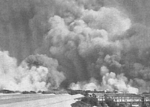Mumbai Harbour
Mumbai Harbour (also English; Bombay Harbour or Front Bay, MarathiMumba'ī bandar), is a natural deep-water harbour in the southern portion of the Ulhas River estuary. The narrower, northern part of the estuary is called Thana Creek. The harbour opens to the Arabian Sea to the south. The historical island of Elephanta is one of the six islands that lie in the harbour. Front Bay is the official name of the harbour, so named because the city started as a tiny settlement facing the harbour. The waterbody behind the original settlement, forming an arc between the former Colaba island and Bombay island, up to the Malabar Hill promontory or peninsula, was similarly called Back Bay. Front Bay is home to the Mumbai Port, which lies in the south section of the western edge of the harbour. Jawaharlal Nehru Port and Navi Mumbai lie to the east on the Konkan mainland, and the city of Mumbai lies to the west on Salsette Island. The Gateway of India with its jetty for Elephanta is the most important tourist destination, followed by the INS Vikrant maritime Museum.
Excerpt from the Wikipedia article Mumbai Harbour (License: CC BY-SA 3.0, Authors).Mumbai Harbour
Malet Bandar Road, Mumbai Wadi Bandar (Zone 1)
Geographical coordinates (GPS) Address Nearby Places Show on map
Geographical coordinates (GPS)
| Latitude | Longitude |
|---|---|
| N 18.96 ° | E 72.85 ° |
Address
Malet Bandar Road
Malet Bandar Road
400009 Mumbai, Wadi Bandar (Zone 1)
Maharashtra, India
Open on Google Maps





